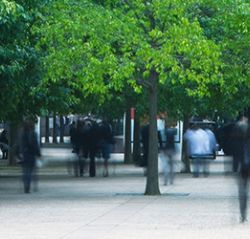Why “short-lived” climate pollutants are anything but
Tom Vandyck |

Since we emit more and more “Short-Lived” Climate Pollutants (SLCPs) every single day, their impact on our climate is permanent. Luckily, solutions are straightforward.
SLCPs are a growing concern in climate circles. The “big four” among them (methane, black carbon, tropospheric ozone and HFCs) cause 45 percent of all anthropogenic climate change.
The fact that this glaring statistic is so underappreciated may have something to do with this category of climate change drivers’ name. The term short-lived distracts from how powerful they really are – up to tens of thousands of times more potent than CO₂. All the more reason to tackle them decisively.
Packing a punch
Here’s how the big four stack up in terms of (staying) power:

While CO₂ is a weak greenhouse gas that lingers for hundreds of years and builds its effect over time as it accumulates in the atmosphere, SLCPs make their impact immediately. According to NASA, methane alone is responsible for 20-30% of global warming since the onset of the Industrial Revolution.
Earth under a hot blanket
As things stand today, SLCPs' limited staying power does little or nothing to ameliorate the problem. Global society is emitting more and more SLCPs, adding them to the atmosphere much quicker than they can break down. This means that we’re covering our planet in a permanent, ever-thickening blanket of heat.
Without decisive action:
- Methane concentrations in the atmosphere are projected to grow by up to 13% by 2038
- HFCs, used as coolants in air conditioners, refrigerators and freezers, are on track to more than double by 2050
- Tropospheric ozone concentrations have increased 2-12% per decade since 1995
- Black carbon emissions have been declining slowly, but remain stubbornly high
Source: CCAC
If we stopped all emitting SLCPs today…
- CO₂ would continue trap heat in the atmosphere for centuries
- Methane and HFCs would be broken down and stop entrapping heat within 15-20 years
- Black carbon and tropospheric ozone would completely dissipate within days or weeks

Let’s tackle SCLPs ASAP
Here’s what it all means: We have to reduce our SLCP emissions as fast as we can, so we can begin to bend overall global warming trends downward in the near term.
While CO₂ traps heat in the atmosphere for centuries, the heating effect of SLCPs would start to recede very quickly. Bottom line: If we act decisively and scale, we will see measurable results within years, not decades.
Want to know how you can help reduce SLCPs?








